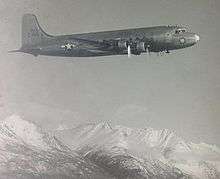1950 Douglas C-54D disappearance
 42-72469, four years before it disappeared | |
| Incident summary | |
|---|---|
| Date | 26 January 1950 |
| Summary | Disappearance |
| Site | Yukon, Canada; in vicinity of Snag |
| Passengers | 36 |
| Crew | 8 |
| Fatalities | 44 |
| Survivors | 0 |
| Aircraft type | Douglas C-54 Skymaster |
| Operator | United States Air Force |
| Registration | 42-72469 |
| Flight origin | Elmendorf Air Force Base (EDF) (EDF/PAED), Anchorage, Alaska, USA |
| Destination | Great Falls Air Force Base (GFA) (GFA/KGFA), Montana, USA |
On 26 January 1950, the Douglas C-54 Skymaster serial number 42-72469 disappeared en route from Alaska to Montana, with 44 people aboard.[1][2] The aircraft made its last radio contact two hours into its eight-hour flight. Despite one of the largest rescue efforts carried out by the US military, no trace of the aircraft has ever been found.[2] It is considered one of the largest groups of American military personnel to ever go missing.[3]
Flight
The aircraft was part of the First Strategic Support Squadron, Strategic Air Command. out of Biggs AFB, Texas. In addition to its eight-man crew, it was carrying 36 passengers, including two civilians: a woman and her infant son.[4] An earlier attempt to depart had been made, but due to trouble with one of its four engines, it was delayed several hours.[5] The flight was from Anchorage, Alaska to Great Falls, Montana; two hours after its eventual departure it reported it was on-course and had just passed over Snag, Yukon – but there were no further messages.
Search

An hour after it failed to show up in Montana, "Operation Mike", named for aircraft commander First Lt. Kyle L. McMichael,[3] was launched, a search and rescue program combining as many as 85 American and Canadian planes, in addition to 7,000 personnel, searching 350,000 square miles of the Pacific Northwest.[4] The search was aided by the fact soldiers and equipment had already been ferried north for the upcoming Exercise Sweetbriar, a joint Canada-US war games scenario.[6] However continuance of the operation also confounded searchers, giving many false positive reports of smoke signals, garbled communications and sightings of "survivors".
On 30 January, a C-47, Air Force serial number 45-1015 from the 57th Fighter Wing, that had been participating in the search, stalled and crashed in the McClintoc mountains. Its crew members were injured, but there were no fatalities; the pilot walked 13 km to the Alaska Highway and flagged down a truck to call in support for his 5–8 crewmates.[3][5][7] On 7 February, a C-47D, 45-1037, from Eielson Air Force Base employed on the search by the 5010th Wing, crashed on a mountain slope south of Aisihik Lake. There were ten crew on board, but there were no fatalities.[8] On 16 February, a Royal Canadian Air Force C-47, KJ-936, crashed near Snag. Again, its four crew members sustained only light injuries.[9] Later its wreckage would be temporarily mistaken for the missing C-54.[10]
The operation was indefinitely suspended on 14 February, as the search planes were needed to investigate the crash of a B-36 that had been carrying, and had dropped, a Fat Man type nuclear weapon, though the core of the weapon in this case was lead.[4]
Aftermath
On 20 February, the search was officially cancelled and notifications were sent to next of kin informing them that the passengers were presumed dead.[11]
Incidentally, there were two contemporary reports of unidentified flying objects by officers stationed at Elmendorf AFB, the first a week before the disappearance, and the second two days after the disappearance. On 19 April, Sgt. William Y. Harrell reported from the control tower that he had seen two UFOs hovering over a hangar emitting a green light, a report backed by other soldiers at the base. On 28 January, Lt. Col. Lester F. Mathison reported seeing three orange cigar-shaped UFOs flying in tandem above the base. Both cases were investigated by the Alaskan Air Command, who ruled only that the objects were neither weather phenomena nor recognized aircraft.[12] The latter incident has also been catalogued as happening on 26 January, within hours of the C-54's last transmission.[13]
In 2012, the descendants of the missing servicemen started a petition to the Federal government, through the We the People petition system, seeking to resurrect the search for their families' remains.[14]
See also
References
- ↑ Ranter, Harro; Lujan, Fabian I. (2008). "Douglas C-54D-1-DC 42-72469 Snag, YT". Retrieved 2011-06-19.
- 1 2 Kennebec, Matt (2010). "Douglas DC-4 C-54D". Retrieved 2011-06-19.
- 1 2 3 USAF #2469
- 1 2 3 What happened to C-54 Skymaster 42-72469?
- 1 2 Chase, Sean (February 4, 2010). "Operation Mike: The disappearance of a Skymaster over the Yukon". The Daily Observer.
- ↑ Exercise Sweetbriar: The Empire Club Addresses
- ↑ A search for answers | The Troy Messenger
- ↑ USAF Accident Report 50-02-07-005
- ↑ RCAF Investigation No.2618
- ↑ Abandoned Plane Wrecks of the North
- ↑ Dagle, Donald W., 1928-1950
- ↑ http://www.alaskawingcaf.org/Alaska%20Heritage/January28-3February.pdf
- ↑ 26 Jan 1950 - Elmendorf AFB, Alaska, USA
- ↑ http://www.kathrynsreport.com/2012/05/family-of-missing-wva-pilot-seeks-to.html
External links
- Baugher, Joe (2011). "1942 Serial Numbers 42-70686 to 42-91973". Archived from the original on 13 July 2011. Retrieved 2011-06-19.